HARDI COMMANDER (2005-current) trailed sprayer:
A used ‘new’ COMMANDER
Nearly 20 years ago, HARDI introduced its stylish ‘New’ COMMANDER series. Not only did it look fresh, the SafeTrack steering system made it extremely well balanced when turning. Given its age there are machines out there for most budgets.
This article was written by Profi UK
When launched in January 2005, the ‘new’ COMMANDER shared little with the previous HARDI trailed sprayers apart from the same name. There was a lot of emphasis placed on stability, with the low-slung profile tank and steering axle being some of the bigger changes. In fact, at the unveiling in Denmark the press were challenged to see if we could get it to ‘cock a leg’, but none of us managed to achieve this feat.
It is a design that has proved itself, so much so that the current COMMANDER looks very similar until you starting opening panels to see the extra technology that has found its way onto the sprayer over the intervening years. Initially there were just two tank sizes: 3200 and 4400 litres and the 6600 one year later; whereas today there are four capacities on offer — 3300, 4500, 5500 and 7000 litres. There are also 8500- and even 10000-litre versions, but these are for the US, Australian and South African markets — not the UK.
Year on year, there have been tweaks to the HARDI front line trailed sprayer, which we will get to. However, to simplify things there are essentially two generations: the ‘new’ version from 2005, which was designated internally at HARDI as the COMMANDER 05, and the 2012 updated version which is known as COMMANDER 11 because the pre-series version was on test in 2011.
Keeping it brief
- Introduced in 2005, it received a big update in 2012 but still looks the same.
- Most popular tank size is 4500 litres paired with either a 24, 27, 30 or 36m boom.
-
The air-assisted TWIN FORCE boom is more popular in Ireland.

The hydraulically powered fans, one either side, provide the necessary oomph.
Chassis and tanks
The chassis is more or less the same across the board, even now. The original 3200 and 4400 do have subtle differences to account for the larger tank. As you'd expect with the extra capacity and having to deal with the weight of liquid fertiliser, the earlier 6600 and current 5500 and 7000 have a much beefier chassis. One other point on the 5500 and 7000 is that it is offered with a two-fold 36m boom; with this option it will have a longer drawbar.
Regardless of tank capacity, the single axle is rated at 10t for road travel at 40km/hr with a full tank (and the TWIN FORCE boom) placing around 1,285-3,302kg on the hitch. This can either be a ring for a drawbar/pick-up hitch or a K80 spoon. Axle suspension has been an option since day one, with drawbar suspension being added for the 6600 and subsequent 5500 and 7000 models. The axle suspension is a hydraulic damping based system.
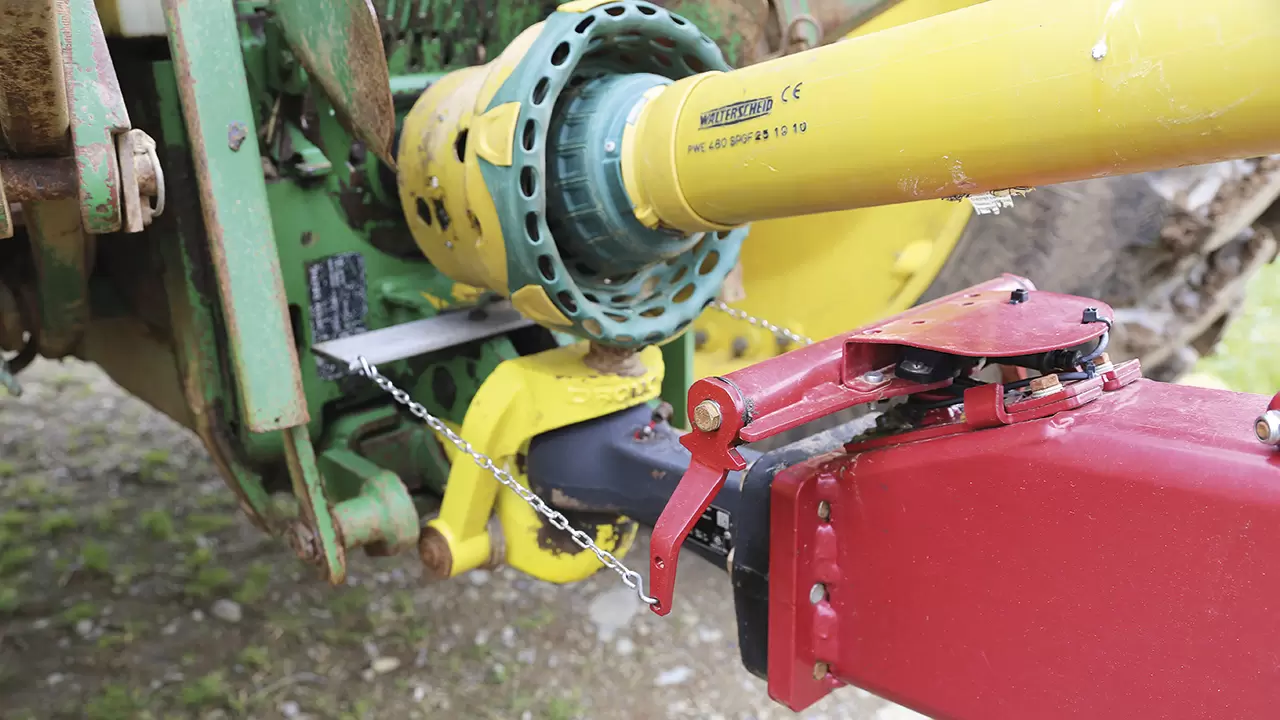
K80 spoon coupling will be more common on newer machines. The steering is controlled from the potentiometers shown here, with the signal wire routed through the drawbar.
The biggest wheel width from the factory is 650/65 R42, but there are machines out there, including the UK, with 900s that have been supplied by the aftermarket trade. Height wise, the tallest tyres are 520/85 R46, giving 835mm of clearance. Regardless of tyre size or track width (1.50-2.00m or 1.80-2.25m) there is no impact on the amount of steering angle, the 3200 having a turning radius of 6.0m (4500, 6.20m and the 5500/7000 is 9.00m).
As mentioned, the SafeTrack steering was a major talking point on the COMMANDER 05. Where other trailed sprayers simply steer the wheels on the axle, SafeTrack has a pivot in the chassis: the rear half includes the axle and the boom carrying linkage so that when you reach the headland the boom remains parallel with the field for longer. The other benefit was the impressive stability when in work.
Downside to the design is that the steering doesn’t function when the booms are folded and you are on the road. The steering angle is measured by a potentiometer mounted at the front of the drawbar.

The steering axle steers the rear half of the chassis with an articulated pivot. As with any mechanical moving parts, check for wear. Downside of the steering system is that it doesn’t work when the booms are folded.
At the COMMANDER 05 launch, the Dynamic Electronic Control (DEC) was introduced for improving safety. Steering radius is determined by the track width and forward speed to help ensure a higher degree of stability — fast turns will result in reduced tracking angles to keep things stable. If the electronic tank volume indicator is preset, DEC will also actively use this information to help determine the safest steering/tracking angle.
Most UK and Irish sprayers will come with hydraulic brakes, with air now becoming a popular alternative. Overall, the chassis is well put together, even on the 7000-litre sprayer, and is well able to take the strain of handling wide working booms. If you see fatigue cracks in the paint in this area, be wary.

All COMMANDER models have a serial plate on the front right-hand side of the chassis. Early models have a secondary riveted plate above, while on later machines the number is also etched into the chassis above the plate. The serial number is also shown on a less detailed plate located above the pump.
The distinctive low-slung tank design is what gives the COMMANDER its key look. As HARDI has done since 1970, the COMMANDER’s tank is made from 12-14mm thick polyethylene, with yellow pigment included in the manufacturing process. If a machine is left out in the elements it can fade but otherwise responds well to a good wash.
In 2011, the tank profile did change slightly as part of the revamp. This was to help with the boom folding to keep the overall width within 2.55m. The tanks on these COMMANDER 11 sprayers will be slightly higher to achieve the same, or in some cases, an increase in capacity, the 6600 making way for the 7000 at this time.
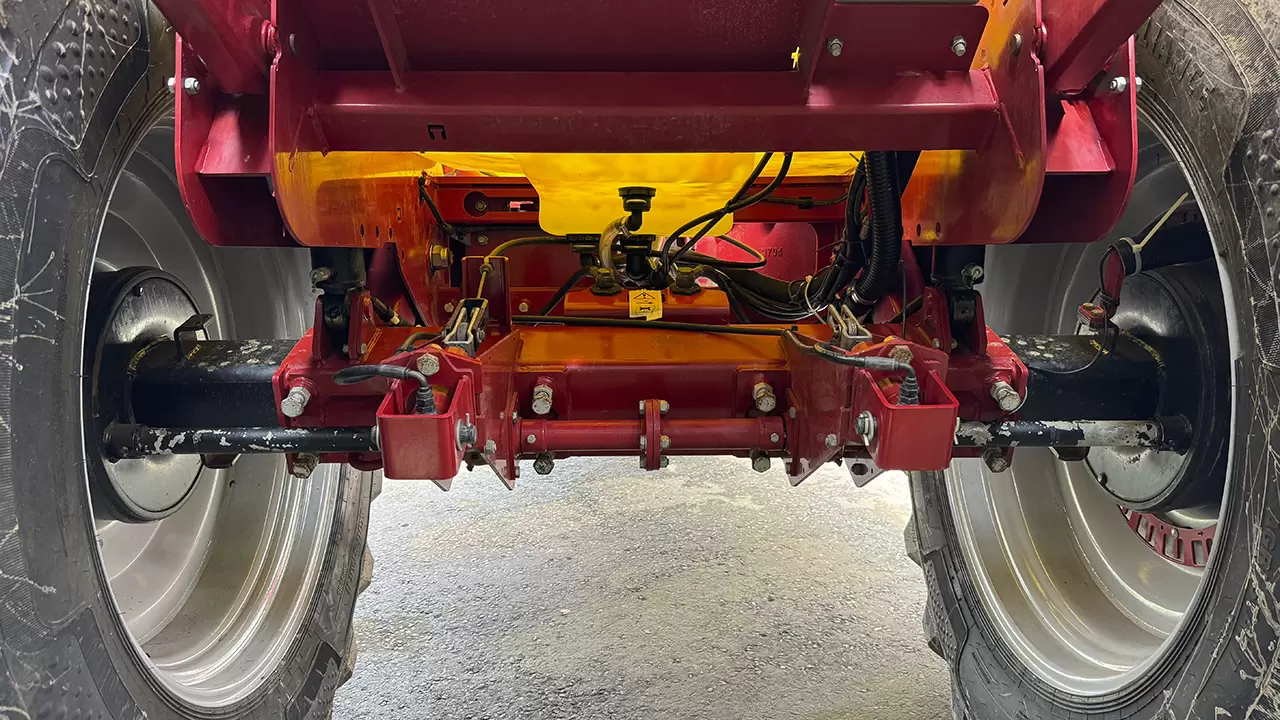
HARDI uses hydraulic damping for the axle suspension. If the sprayer is not sitting level or pitches under load it could need repressurising. It should be set to around 70 bar.
Booms
Early COMMANDER owners would have had the option of 18-28m DELTA, 24-36m FORCE and an air-assisted 18-36m TWIN FORCE. On the latter, this has proved to be more popular in Ireland and Scotland, but less so the farther south you travel in England.
HARDI still regards the air-assist as a massive benefit to users, not just in giving you more spraying day options but also the opportunity to reduce chemical concentration as the air stream helps the droplets reach the underside of the crop leaf where there is less protective waxing and therefore better absorption. The other part of the sales pitch from Peter Dahl, sales director at HARDI NORTH, is that research has shown that droplets lose their kinetic energy after 35cm and drift is possible for up to 6.0km! By using the air stream produced in the boom, the droplets have a better chance of reaching their intended target. And there is also a massive amount of engineering science involved in the TWIN FORCE’s design to prevent the air flow causing turbulence.
Sticking with the air-assist boom, HARDI’s third generation version, the TWIN FORCE 3.1, was introduced in 2016. Key changes included the greater use of lightweight aluminium including the outer section on the 32-36m boom. The folding rams benefited from horizontal yaw control, which integrated an accumulator into the ram cylinder — this can be identified by three hydraulic pipes on the ram instead of the usual two.
So, what is the downside to TWIN FORCE? The extra cost and weight are probably the biggest negatives. The added mass will also take its toll on pivot wear, more than a conventional boom arrangement. The sleeve itself can also wear.

On TWIN FORCE booms check the condition of the sleeves for tears or fraying allowing air to escape.
The DELTA and FORCE booms morphed into the DELTA FORCE in 2014. This spans 24-39m and is a heavier duty all-steel construction. It benefits from hydraulic locked sections, hydraulically damped yaw movement and a management system with up to five sensor units. If, for whatever reason, electric power is lost, there is also a manual boom management function — to keep the machine going.
The DELTA FORCE can be two- or three-section folding with the usual 50cm nozzle spacing or 25cm. An aluminium bumper is mounted on the front of the boom to protect the nozzles.
Obviously, if you are buying a used sprayer, boom width and tank capacity are going to be the deciding factors. With HARDI you will then have to figure out if you want a conventional frame design or air assist, but geography will play a part in what is on the used market.
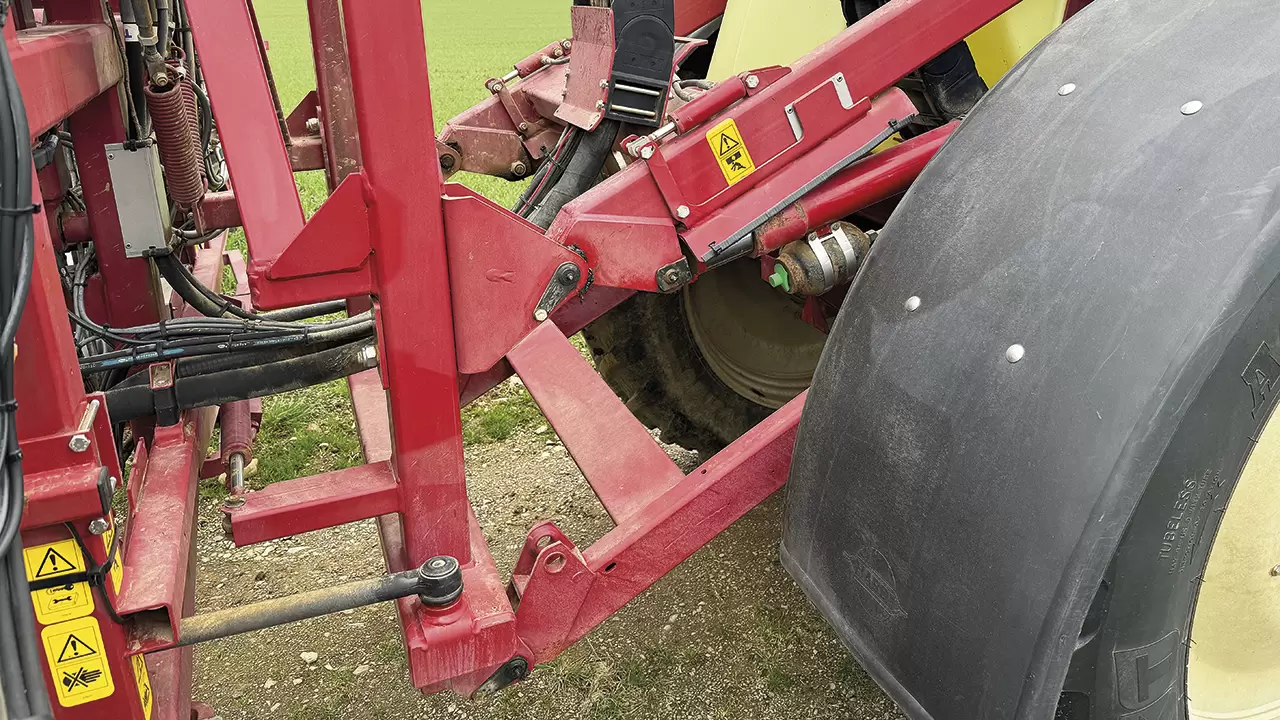
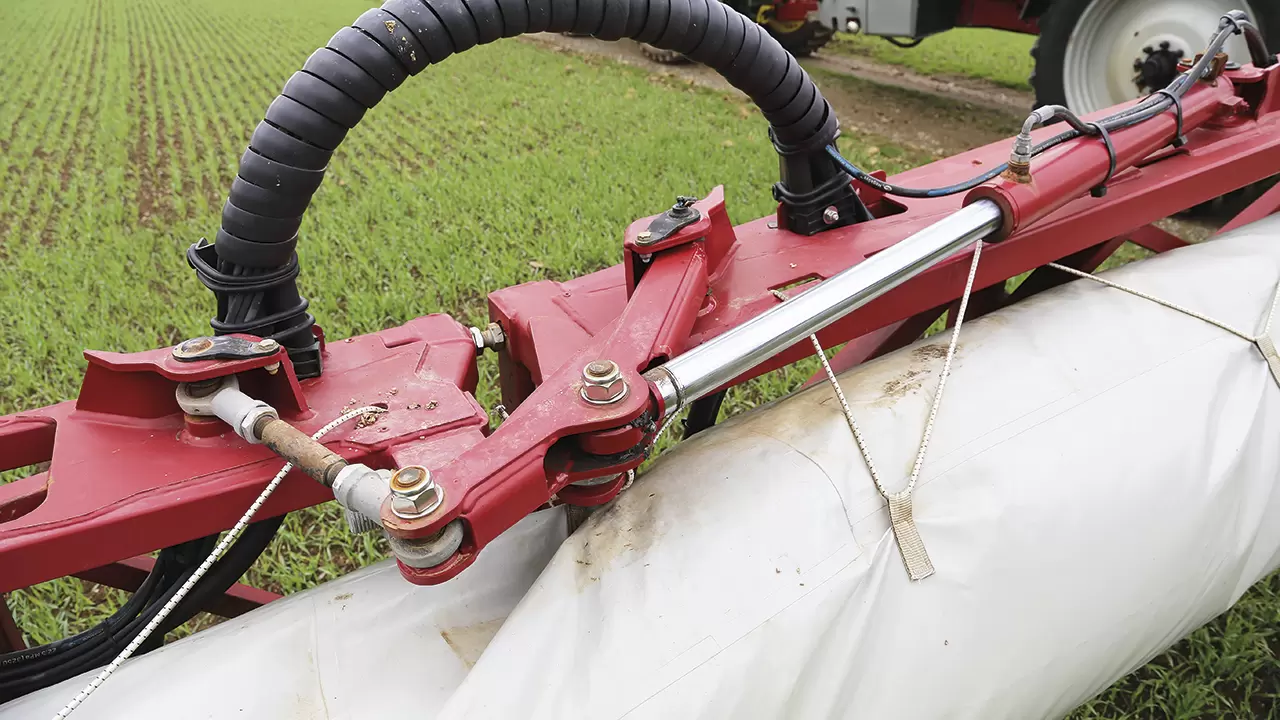
The overall appearance is the main thing to check on any used COMMANDER sprayer. Pay particular attention to signs of rust including any that appears behind protective stainless steel plates. Then give the various pivots a good look-over. Bushing kits are available but also budget for fitting time.
When the intelligent ‘i’ range was added, one of the new bits of tech was the AutoHeight feature, which relied on Norac’s UC5 ultrasonic sensors. These were swapped for UC7 units in 2016. The difference between the two types is that the newer version has an AutoTerrain function with NegativeTilt and a new type of sensor that delivers both distance and angle sensing.
Users say that the hydraulic system for the boom folding/unfolding is very good, as are the break-back end sections.
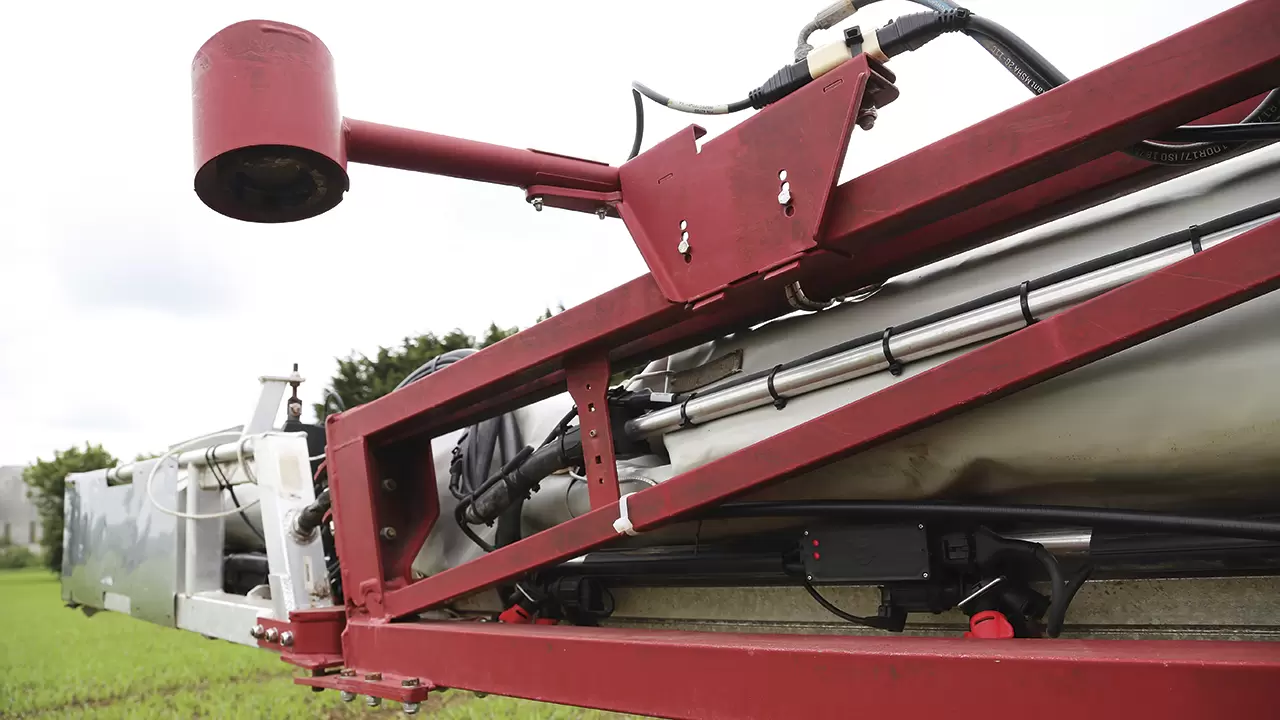
HARDI used NORAC boom height sensors, changing from the UC5 to UC7 in 2016.
One operator has pointed out that, if the boom does contact the ground, then the horizontal rotating nozzle bodies can turn, resulting in using the wrong nozzle. They also suggest that the auto cleaning can take time as the return lines are smaller than the feed, which, in turn, creates a hold-up point both for chemical and residue.
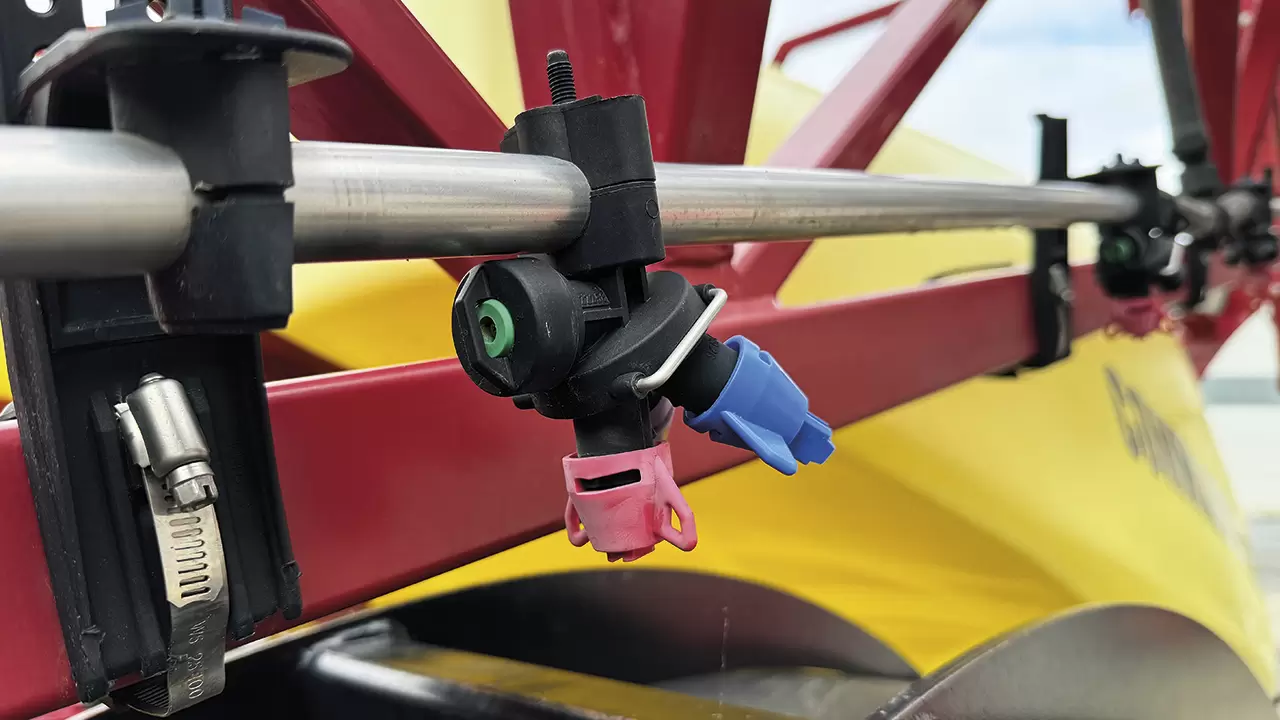
Stainless steel spray lines work well, but watch out for pinholes appearing. Replacements can be costly. Most sprayers will be fitted with a three-way body but some will have five.
AutoWash was part of the ‘i’ range when it was launched back in 2006. This has three rinsing programs:
BoomFlush — this rinses the spray lines on the boom as well as the pump and control unit without diluting mix still in the main tank.
FastFlush — here the empty tank is briefly rinsed for when you will be continuing with the same mix the next day.
MultiRinse — water from the clean water tank (500 litres) is used to wash the full spray liquid engaging parts of the sprayer going through a multi-step program. This takes at least 20 minutes to complete.
Pump
The COMMANDER started with the 463 family of pumps with capacities of 276l/min with the option of a 322l/min unit. Then, in 2014, HARDI started using its 464 pump, the firm’s fourth generation pump. This has capacities ranging from 280-349l/min, depending on the variation, which can be powered using the 540rpm or 1,000rpm pto. Hydraulic drive is also an option on conventional boom sprayers. The air-assist needs a pto-driven spray pump, as power is sourced off the back for the air-generating hydraulic driven fans.
COMMANDER timeline
2005 – New’ COMMANDER debuted with 3200- or 4400-litre tanks and a choice of HC 2500 and HC 5500 controllers; boom options of DELTA, FORCE and TWIN FORCE. Receives a Silver medal at Agritechnica.
2006 – COMMANDER ‘i’ Intelligent with HC 6500 controller and advanced features as standard (see text). Addition of 6600-litre tank option.
2008 – NAVIGATOR with DELTA booms announced to replace still available COMMANDER Classic. ‘New’ COMMANDER offered with TWIN FORCE boom up to 36m.
2009 – COMMANDER Classic production ends. RANGER debuted. BoomPrime introduced on COMMANDER.
2010 – ISO compatibility option.
2012 – COMMANDER is redesigned with more than 37 updates with capacities of 3300, 4500, 5500 and 7000 litres. The new liquid regulation system DynamicFluid4 with 4-sensor technology receives a SIMA award in 2013.
2014 – DELTA FORCE conventional boom program — two-fold 27-28-30m and three-fold 32-33 and 36m, compact in transport 2.55m, SoftFold boom folding. The fourth generation 464 series of pumps is introduced.
2016 – Third generation TWIN FORCE 32-33-36m — hybrid steel and aluminium boom, hydraulic damped AntiYaw function, new folding system.
2021 – New software. Single nozzle on/off added to the options list.
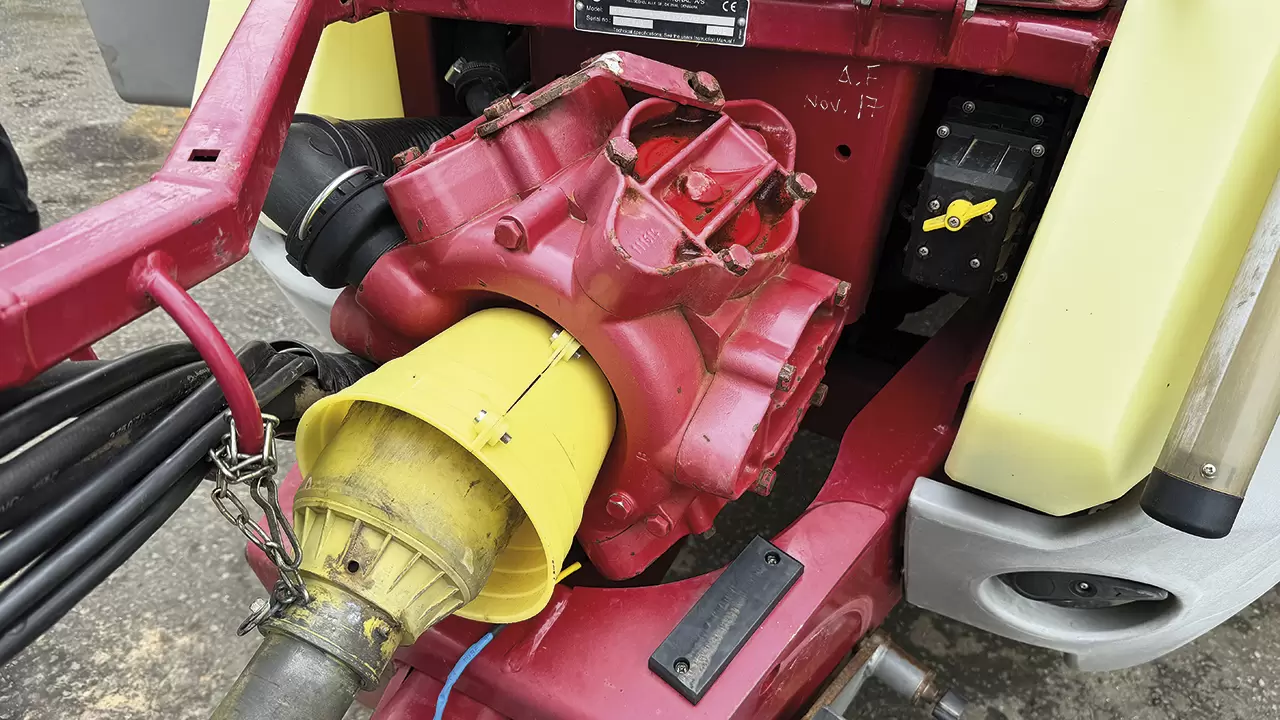
The COMMANDER initially started with the 463 series pumps …
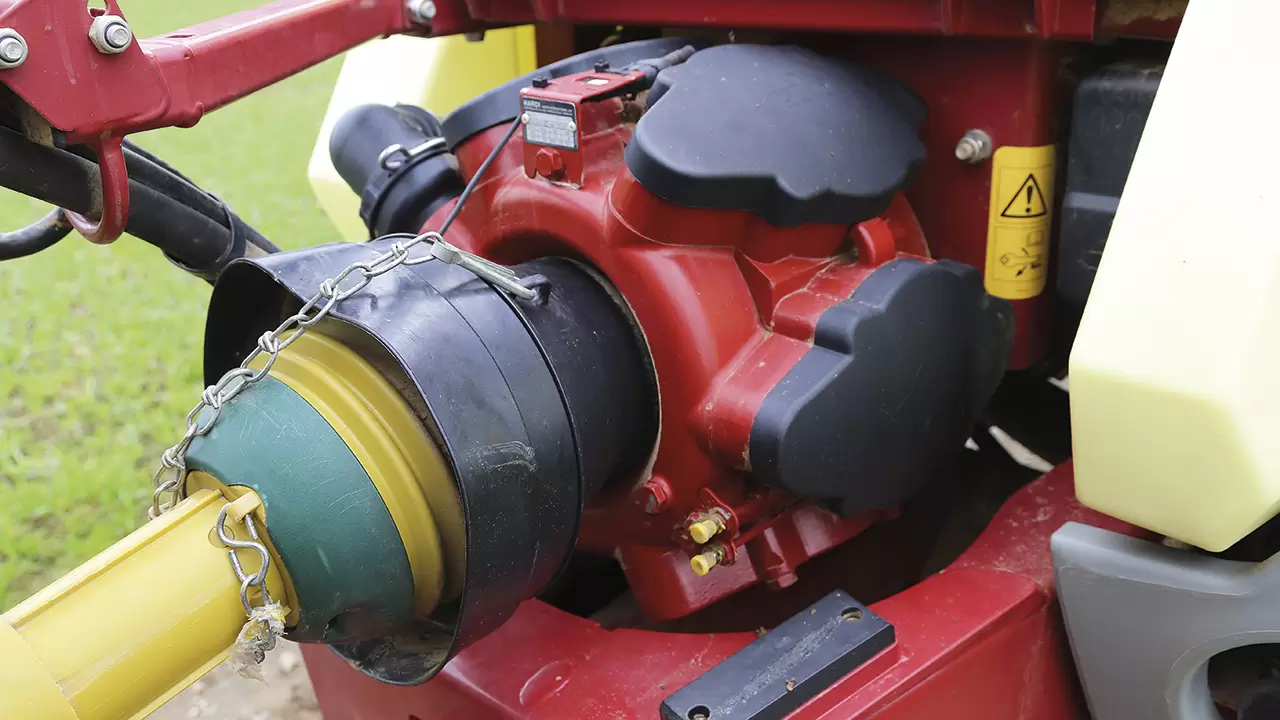
… before switching to the 464 in 2014, which has easier grease points on the lower right among other changes. Both pump types are dependable but do need servicing at least every two years for best performance.
HARDI also supplies its spray pumps to a maker of plane de-icing machines, where the work cycles are much higher. One of the major improvements on the 464 pump is the easier to reach remote grease points, but from a performance point of view the crankshaft and conrod movement has been further refined to avoid any peaks and troughs and with it the risk of cavitation.
Regardless of it being a 463 or a 464 generation pump, we will repeat the advice we were given in our 2011 used COMMANDER article: the pump should be serviced at least once every two years.
Filling
With the 05 series machines, HARDI introduced a new filling system and induction hopper. The plastic lid on the induction hopper flips open 180⁰ to create a useful workplace. The simpler model available at launch had two large rotary valves: one for suction, the other pressure, which it called SmartValve. Three smaller valves cater for the flow from the induction hopper, agitator and the FastFiller with up to 800l/min.
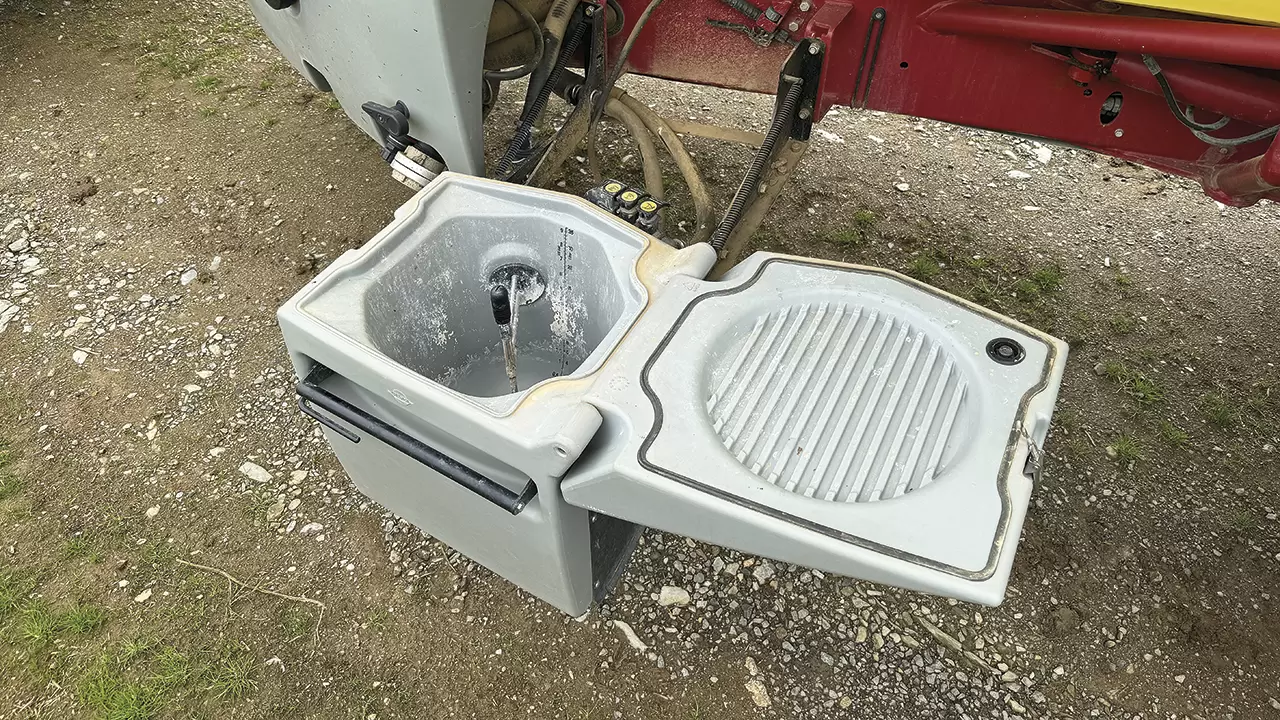
The layout and power of the induction hopper was a key part of the COMMANDER 05 development. Operators like the hopper.
With the ‘i’ machine, one of the intelligent functions was AutoFill, with a sensor in the tank used to determine when the required amount of liquid in the tank was reached and automatically close the suction valve. By the filling area a nifty external control box was added. An automatic agitation system also altered the amount of oomph depending on how full the tank is.

Likewise the pressure and suction rotary controls were designed so that their current position could be easily seen.
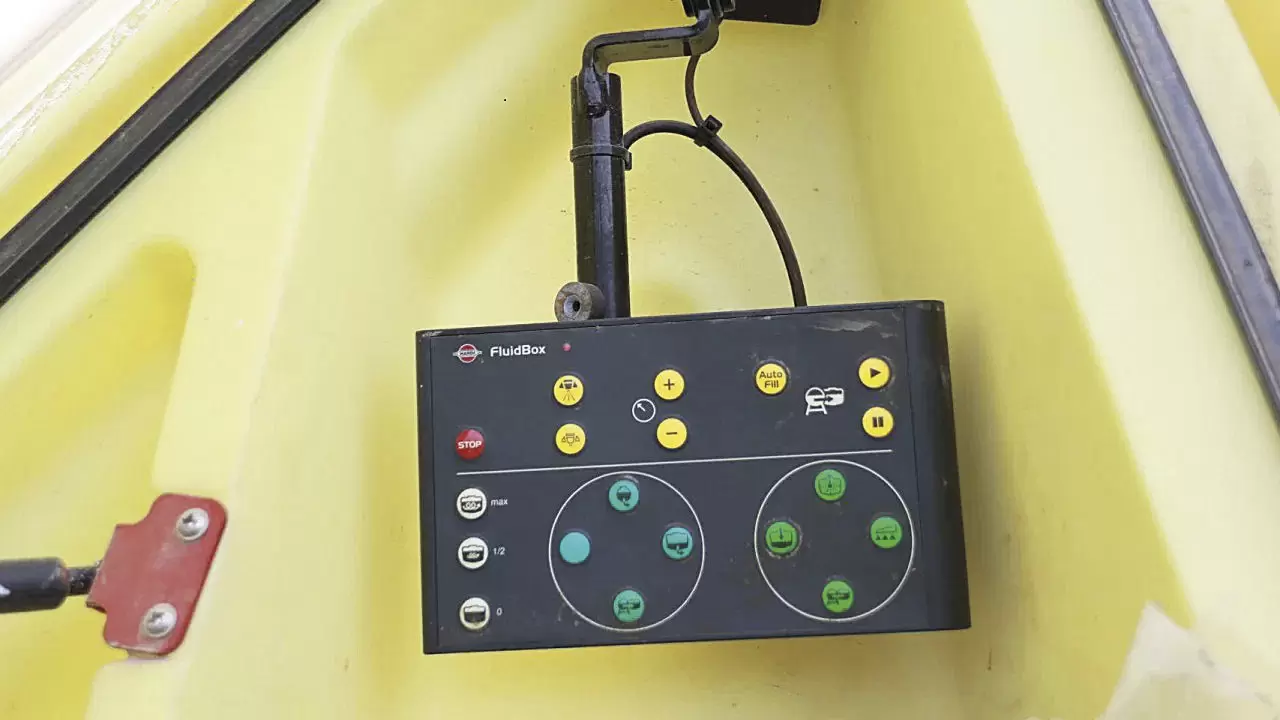
On the intelligent version, filling is carried out through the sprayer's external FluidBox.
Operator feedback here is that the induction hopper on the COMMANDER 05 was already very good, with COMMANDER 11's being even better, with enough pressure for thoroughly cleaning cans. Even sticky powders are not an issue here. Users we spoke to suggested the digital tank volume indicator is nowhere near as accurate as it needs to be, but there is the dry sight gauge to act as back-up. Dust can cause it to stick, though.

As well as a pressure gauge, there is a gauge to show the current state of the main filter.
Control boxes and screens
This is where you'll find the biggest difference on used COMMANDER models. As technology has advanced, so too have the main controls to match. Here we are going to look at each one separately.
HC 2500: This was the entry-level control box for the ‘new’ range and was a carryover from the old COMMANDER. It is what it is, toggle switches and dials allowing the user to tweak settings. The display will show you the current application rate etc, but more critically for the used buyer is that even this simplistic box will include the number of total spraying hours.
HC 5500: At the time this was the higher spec controller and was packaged with the optional SafeTrack steering axle so it is pretty much the default fit for a COMMANDER 05 in the UK and Ireland in the early years. It was already tried and trusted in the older COMMANDER models and is simple to get to grips with.
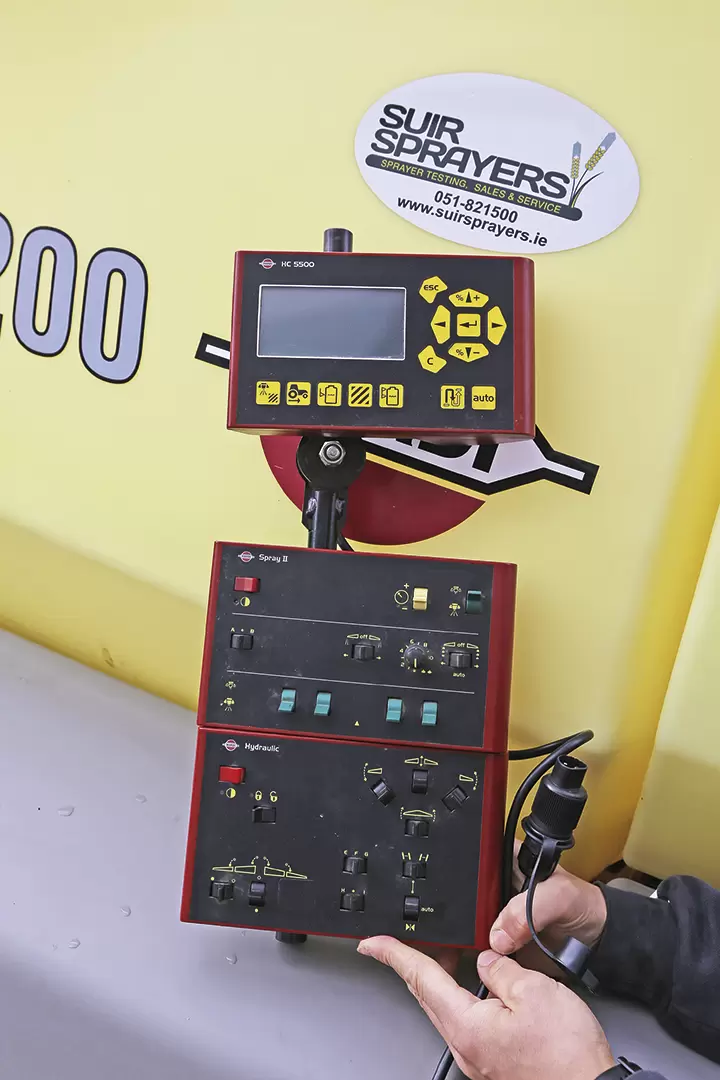
The HC 5500 control version was the higher tech alternative to the HC 2500. It will be more prevalent on UK machines as it was packaged up with the steering axle option.
HC 6500: This was launched as part of the ‘i’ range and was available up to as recently as 2021. Any sprayer with one of these control boxes can have ISOBUS retrofitted, although this route is possibly not that economical.
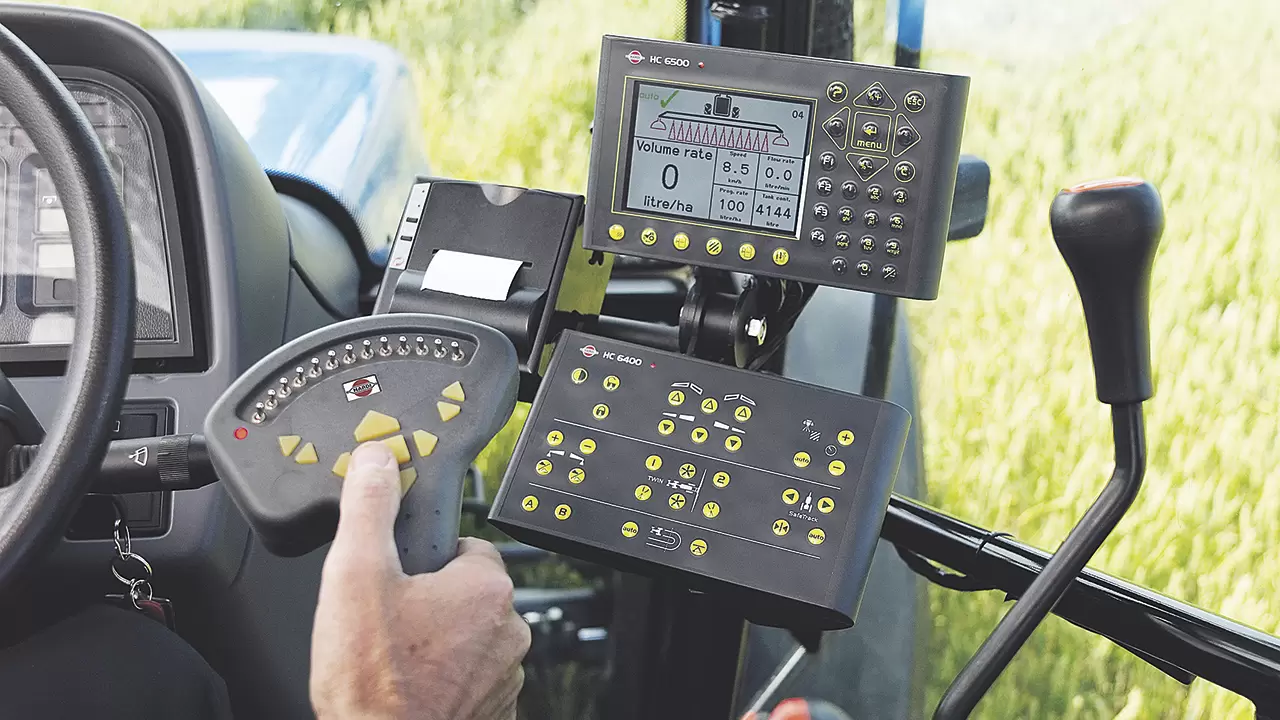
With the COMMANDER ‘i’ model HARDI introduced the HC 6500 complete with colour screen and separate joystick. This change came in 2006.
HC 8500 / 9500: Sourced from AgLeader, these full-colour touch-screen displays were added in 2012 and were phased out in 2015. They are 8in and 12in respectively and can be used as an alternative to the spray tractor’s ISOBUS compatible terminal. The HARDI SetBox sits alongside, with push buttons for looking after most of the main sprayer functions. The firm's joystick is then used for turning sections on and off.
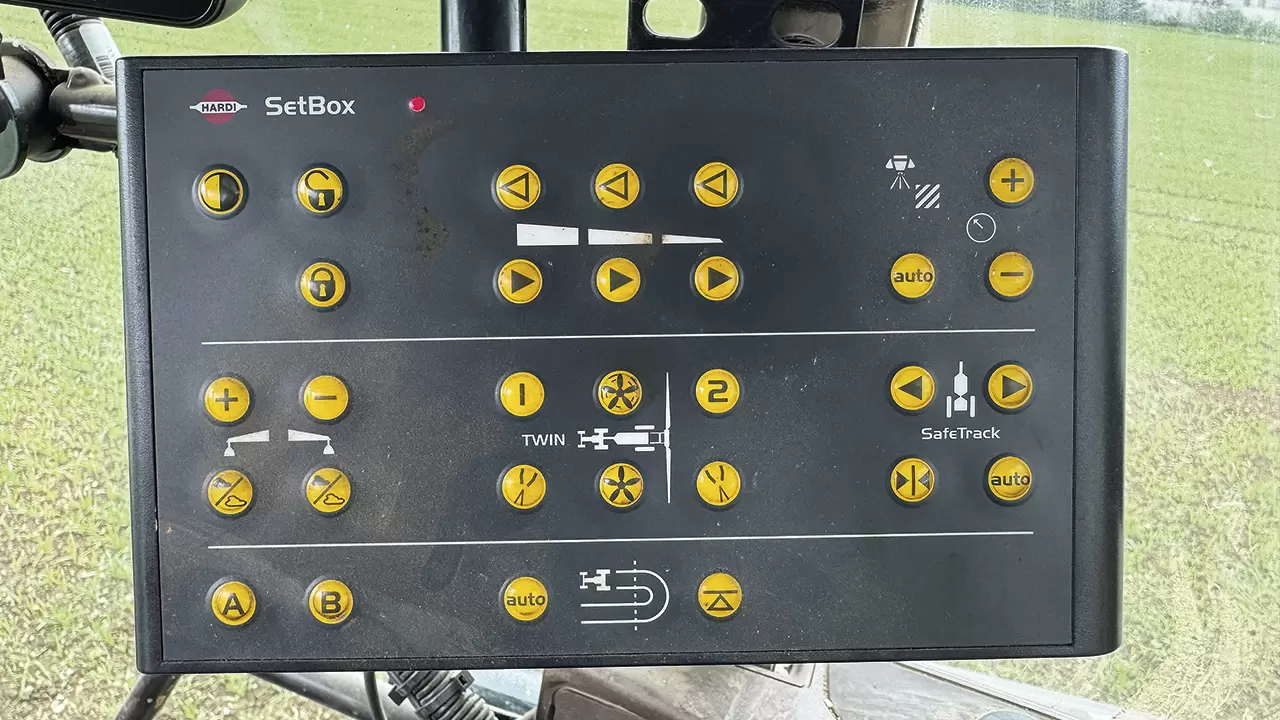
HARDI still utilises a push button control box for the main sprayer functions …
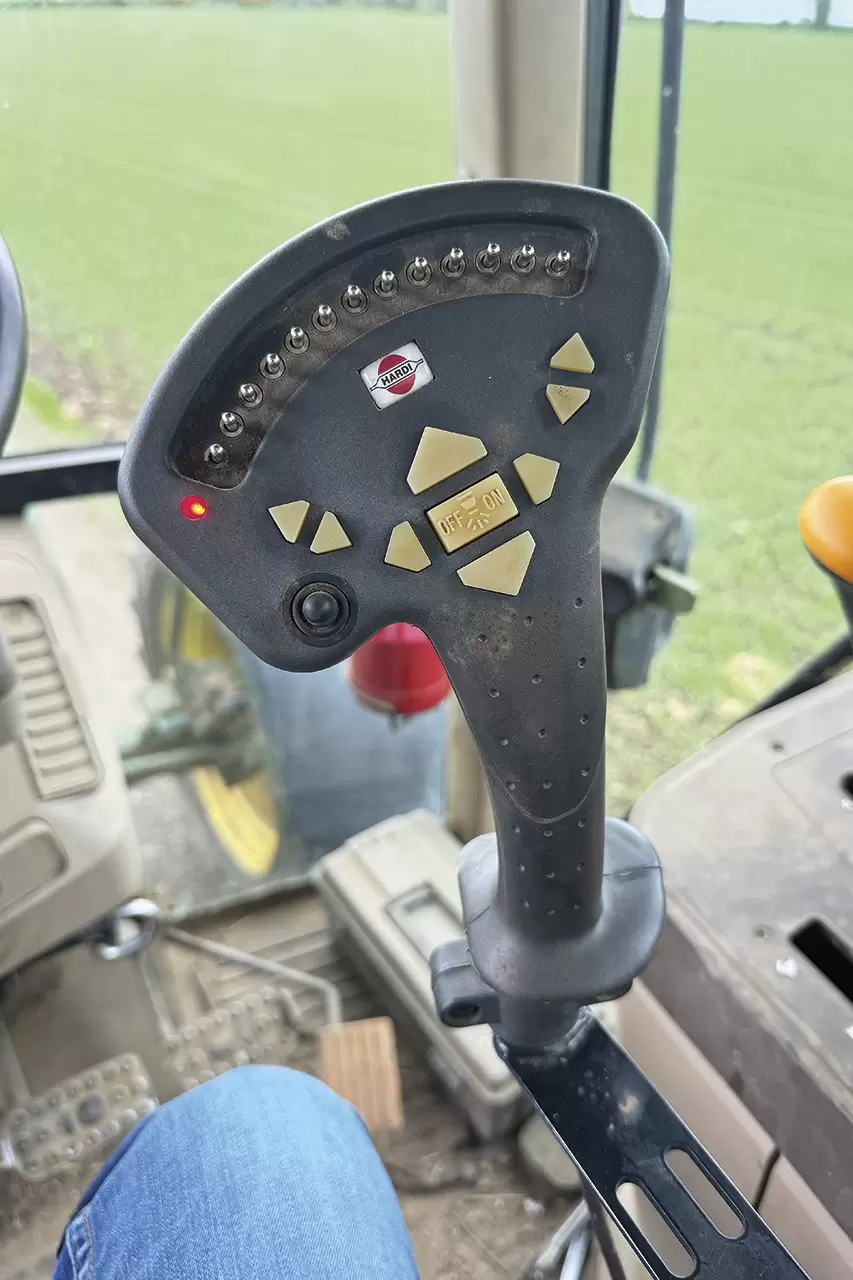
… along with the joystick for operating the sections. The 'stick' can be more conveniently positioned next to the operator for comfort.
HC 8600 / 9600: Introduced in 2016, these were higher definition than the previous AgLeader displays. They are still available today.
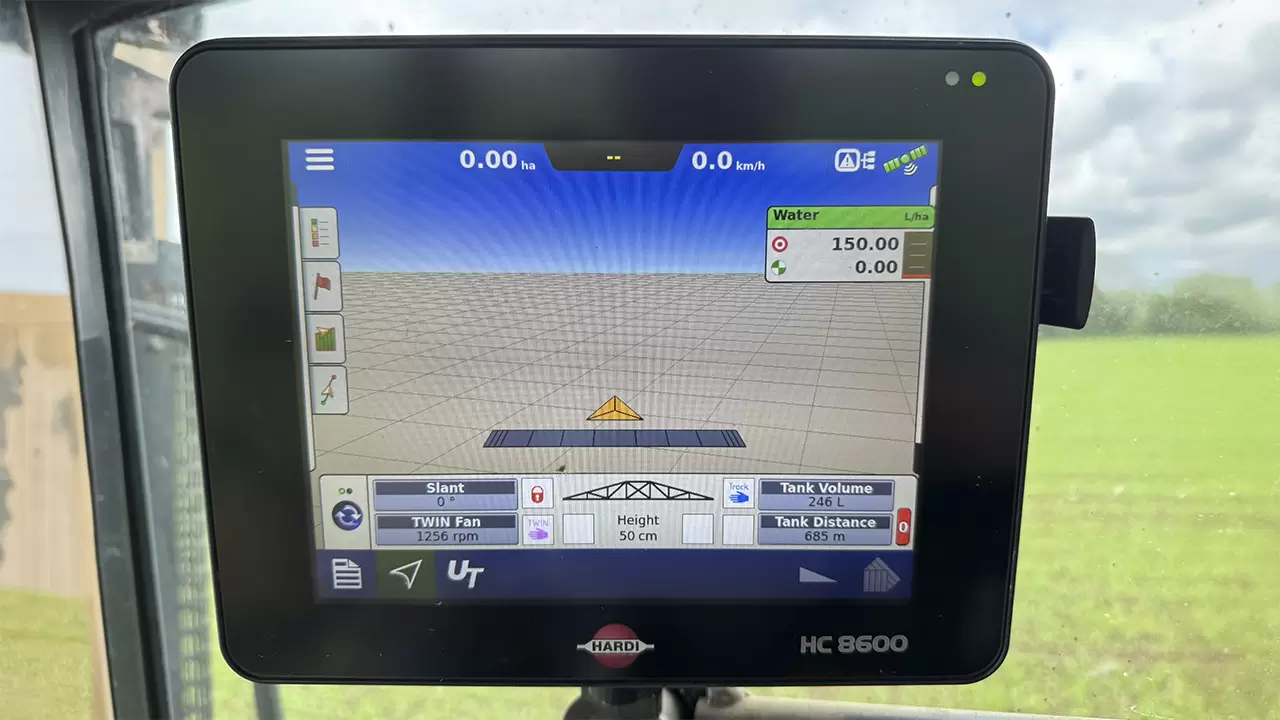

From 2010 the COMMANDER was ISOBUS compatible, but uptake was initially slow. This has changed more recently as the pool of compatible tractors becomes bigger. For non-ISOBUS tractors, HARDI used rebadged AgLeader displays with the HC 8600 shown here along with the larger HC 9500.
HC 8700 / 9700: For 2020 HARDI added these two screen options, which are sourced from Topcon.
One of the main benefits of the HC 8700 and 9700 is that they're compatible with agrirouter for the remote uploading/downloading of data. This is very popular in certain markets where it's used with farm software.
Summary
UK farmers have an abundant choice of trailed sprayers from domestic and international players, while Irish growers have had more of a penchant for the continental makers due to strong distributors retailing machines through the farm machinery dealer network.
HARDI has always been a good seller in both markets. The COMMANDER 05 certainly sets the bar for its looks and, with the introduction of the ‘i’ version, there was a whole host of useful automatic features added.
Although it has been on the market for nearly 20 years now, it has been a case of successive tweaks rather than a complete revamp. So, for the used buyer it will be a case of seeing which of these are important to you after the main deciders of tank capacities and boom width have been finalised.
As far as back-up and parts, the technical expertise at HARDI UK has been given a shot in the arm with a number of new staff. Users we spoke with suggested spare parts supply is frustratingly slow, and some of the prices are noticeably more than for other makes.
A recent NSTS certificate should give some confidence on a particular used buy that it was functioning well enough to pass.
Thanks to Peter Dahl at HARDI, Pat Kenny at IAM, Suir Sprayers, Russells, Claas Western, RVW Pugh, Francis Kehoe and Cleanacres Machinery for your help with information.